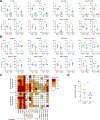Recombinant H77C gpE1/gpE2 heterodimer elicits superior HCV cross-neutralisation than H77C gpE2 alone
- PMID: 38986744
- PMCID: PMC11830426
- DOI: 10.1016/j.jhep.2024.06.029
Recombinant H77C gpE1/gpE2 heterodimer elicits superior HCV cross-neutralisation than H77C gpE2 alone
Abstract
Background & aims: An optimal HCV vaccine requires the induction of antibodies that neutralise the infectivity of many heterogenous viral isolates. In this study, we have focused on determining the optimal recombinant envelope glycoprotein component to elicit cross-neutralising antibodies against global HCV genotypes. We compared the immunoreactivity and antigenicity of the HCV genotype 1a strain H77C-derived envelope glycoprotein heterodimer gpE1/gpE2 with that of recombinant gpE2 alone.
Methods: Characterisation of the envelope glycoproteins was accomplished by determining their ability to bind to a panel of broadly cross-neutralising monoclonal antibodies. Immunogenicity was determined by testing the ability of vaccine antisera to neutralise the infectivity in vitro of a panel of pseudotyped HCV particles in which gpE1/gpE2 derived from representative isolates of the major global HCV genotypes were displayed.
Results: gpE1/gpE2 binds to more diverse broadly cross-neutralising antibodies than gpE2 alone and elicits a broader profile of cross-neutralising antibodies in animals, especially against more heterologous, non-1a genotypes. While not all heterologous HCV strains can be potently inhibited in vitro by gpE1/gpE2 antisera derived from a single HCV strain, the breadth of heterologous cross-neutralisation is shown to be substantial.
Conclusions: Our work supports the inclusion of gpE1/gpE2 in an HCV vaccine in order to maximise the cross-neutralisation of heterogenous HCV isolates. Our data also offers future directions in formulating a cocktail of gpE1/gpE2 antigens from a small selection of HCV genotypes to further enhance cross-neutralisation of global HCV strains and hopefully advance the development of a globally effective HCV vaccine.
Impact and implications: An HCV vaccine is urgently required to prevent the high global incidence of HCV infection and disease. Since HCV is a highly heterogeneous virus, it is desirable for a vaccine to elicit antibodies that neutralise the infectivity of most global strains. To this end, we have compared the immunoreactivity and antigenicity of recombinant H77C E1E2 heterodimer with that of H77C E2 alone and show that the former exhibits more cross-neutralising epitopes and demonstrates a broader cross-neutralisation profile in vitro. In addition, our data suggests a way to further broaden cross-neutralisation using a combination of E1E2 antigens derived from a few different HCV clades. Our work is relevant for the development of an effective global HCV vaccine.
Keywords: HCV; antibody; cross-neutralisation; vaccine.
Copyright © 2024 The Author(s). Published by Elsevier B.V. All rights reserved.
Conflict of interest statement
Conflict of interest
Authors (JK, HTL, ML, DH, AL, KC, MW, JJ, JKK, DLT, MH, JL) own stock in Aurora Vaccines Inc., which is developing a HCV vaccine for clinical and commercial use.
Please refer to the accompanying ICMJE disclosure forms for further details.
Figures




References
-
- WHO. Global hepatitis report 2017.. Published online April 28. 2017. p. 1–83.
MeSH terms
Substances
Grants and funding
LinkOut - more resources
Full Text Sources

